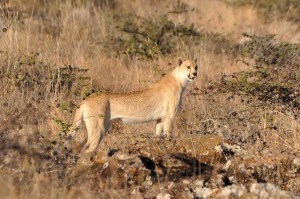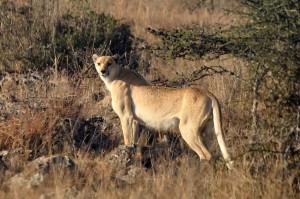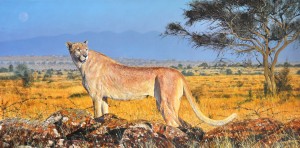
September 10, 2011
The site io9 has ended their “Cryptid Summer” contest with a winner. The pick was an entry with some rather striking photographs of a White Cheetah in Africa.
The prize of $2000 was won by Guy Combes (not Combs, as io9 has it), who chased down the rare White Cheetah. The panel of expert judges “included Mark Siddall, a zoologist who specializes in leeches at the American Museum of Natural History in New York; Loren Coleman, a widely-recognized expert in cryptozoology and creator of the International Cryptozoology Museum in Maine; photoshop expert and designer Paul Hogan (also known as Garrison Dean, viral video creator extraordinaire); along with io9 editors Charlie Jane Anders and…Annalee Newitz.”
Yes, I was on the panel and felt that the White Cheetah might be a good cryptid choice. Within cryptozoology, there has been some focus in the recent past on the quest for the “King Cheetah,” although it turned out to be a pattern mutation.
White cheetahs have been sighted and discussed since, at least, 1608*. I could see some expeditions out to discover if this new find is a part-albino or a new subspecies of the known cheetah. Of course, it is a real cryptid, an unknown, as yet unverified species, due to the fact it has not been captured, alive or dead, in a modern situation where DNA has been taken, to note one of many criteria. This cat could be one of many things, perhaps, but the speculation is that it is a form of cheetah, naturally. Since we technically do not know what it is, it is a cryptid. (For those still confused, specifically, by what is and isn’t a cryptid, please see what I have written previously on “cryptoterms.”)
Let me share the remarkable photographs submitted of this mystery cat:




The White Cheetah painting.
See more details here at the io9 site.
Following are the words of the photographer, Guy Combes, who took the images:
Back in December [2010] I was told about this incredible ‘morph’ phenomenon that has not been seen for over 90 years, and that there was a pressing need to monitor and protect it while raising awareness of the species as a whole. The last one recorded was shot in Tanzania in 1921. By ‘morph’ this means a genetic colour variation, the most well known being the ‘King’ cheetah, specimens of which have only occurred in South Africa and Zimbabwe. The Mughal Emperor of India recorded having a white cheetah presented to him in 1608, saying that the spots were of a blue colour and the whiteness of the body also inclined to blue-ishness. This suggests a chinchilla mutation which restricts the amount of pigment on the hair shaft. Red cheetahs have dark tawny spots on a golden background and some desert cheetahs are very pale to be more camouflaged in their environment. There are also reported cases of melanism or albinism, but the latter does not apply to this cheetah. The only reported cases of this morph which scientists believe is a recessive gene like the king cheetah, have been in East Africa from the subspecies, acynonix jubatus raineyii.
I was hooked from the first moment I heard about this, and needless to say I immediately wanted to get reference, but the prospect of finding it seemed incredibly remote. The only hope I had was that the cheetah, a male, was still with his mother and occupying the same area before he reached the age of independence. This time was fast approaching so the need was urgent to find him. Apparently he already showed small signs of conflict with other male cheetahs trying to get to his mother who had come into season again. Here is an account of my search:
I was at home at Soysambu when I got the call that a window of time was open for me to have a vehicle and a spotter plane available to search the 100,000 acre area in which the cheetah was believed to be. That’s quite literally the equivalent of a needle in a haystack. So I made my way there there with not a great deal of optimism other than I thought I would get some good background reference.
Our first search was in a plane made by the Israeli army to train pilots and coincidentally called a Cheetah: a small frame of aluminium poles and nylon fabric with a propeller and wheels. I confess to having raised anxiety levels when on small aircraft due to a couple of infamous past experiences, so I wasn’t thoroughly enthused when the pilot (despite being one of the finest in Kenya), explained that we would be doing an hour of mostly low level flying with tight turns. There were two big storms on either side and the air was being moved rapidly between them so we spent most of the flight going sideways. I gritted my teeth and tried to concentrate on searching the ground but it was pretty much a pointless excersise.
So back on the ground I set off in a landrover to search the area, most of which has no roads and at least managed to get some good background reference in the evening light. I figured that I could probably work this one with photographs someone had taken of him as a much younger cub and reference I had of adult male cheetahs. After all, he was just the same but with no spots, right? So I headed to town and met some friends for a few drinks. Then my phone rang:
– “We’ve just found him!!!”
– “did you get any pictures?”
– “no sorry didn’t have a camera”
– “ok I will be up and out there at sparrows!”.
My host was there warming up the plane and getting ready, however I suggested I trade places with someone in one of the vehicles so that at least if he was found I would be able to get some good ground shots. We set off and watched as the plane traversed from one end of the horizon to the other trying our best to follow, but silence on the radio. By mid-morning we once again had to call it off and regroup for coffee. Everyone dispersed and I caught up with some sleep. Pretty much the same thing that evening, and I was beginning to lose hope. Cheetah can cover huge distances at night but usually stay in the same area during the day, and by the following morning two nights had passed. My only hope was that because he was with his mother, that they were still occupying the same area.
Once again, eternally optimistic, my host set off in the plane with another hapless volunteer that had to take my place – I felt like such a lightweight. Turns out that I made 100% the best decision I could have. As we were thundering over the roadless plain in the landrover, I suddenly noticed that the plane had started to circle. My heart shifted into first gear. Our radio was out but the plane had unmistakably made several tight turns and was continuing to do so until we managed to get close to the circle it was making. Of course it happened to be an area covered in large rocks and low trees, so I was sitting forward in my seat, clinging to the dash with my face up against the windshield trying to keep my camera on my lap as we bounced ridiculously over huge boulders.
Then there he was. A white spot in a landscape painted gold by the morning sun. As we got closer we had to be very tactical about our speed and noise level which is pretty much impossible in a landrover, especially when you’re driving over big rocks. Lots of “ok forwards…”, “STOP” and “shhhhhhh!!!” in theatrical whisper. He let us get quite close before hunkering down and slinking off in the direction of even more vehicle-unfriendly rocks. But we managed to keep up and he didn’t seem overly anxious about us. We barely noticed that his mother was following at a distance. We were with him like this for about 30 minutes that seemed like about 5 seconds. Then having punished the vehicle to the extent that I was amazed the wheels were still on, I noticed that he began to move away from us, walking at first, then trotting, then a good run. My heart sank and I thought my last view would be him running away in fear, but it became quickly apparent that he was focusing on something. The sun was in my eyes but I could make out a dark shape moving fast in a perpendicular direction to him. Binoculars out – it was a Serval Cat!!! Next thing we knew he was running at full tilt after this thing, zigzagging first then long stretches of blindingly fast speed. Alas, we were in the worst part of the boulder field and there was clearly no option of a pursuit. So after he disappeared and the dust settled we looked at each other and let out a looooong sigh. Amazing.
I came away feeling as though I had seen Bigfoot or the Loch Ness Monster. And got photographs!!! This is not my first involvement with cheetahs. I’m very familiar with the species in terms of the personal friendships I have with people who work tirelessly to ensure their survival, and the subject matter I have been asked to paint. From my childhood I will never forget visiting some friends of my parents in Naivasha who had a pair of domesticated cheetah. Oblivious to their presence I ignored a well intentioned warning and took off down their garden, very quickly finding myself face down in the grass with a cheetah on my back. Fortunately my Dad, a well rehearsed rugby player, dealt with my assailant quickly and efficiently. However, at no point did I feel as though my life was in danger. It was just like being roughed up by a playful dog. So in a way I have always felt a strong connection with them, and I am now practically obsessed with this individual animal and the unforgettable experience of finding him and being allowed to spend half an hour or so with him. I hope I have done him justice on canvas.
The painting itself, aside from being the most accurate portrayal I was capable of, includes certain elements that are important to the story. The area is one that accommodates one of the highest densities of cheetah populations in East Africa. This could be as a result of a distinct lack of other larger predators that would be a threat to their existence, a large prey base, and an area relatively protected from development. I wanted to include this latter factor and have faintly suggested a settlement complete with cell phone tower on the ridge in the middle distance. This, of course, is the greatest problem that cheetahs face in our ‘human’ age. The locations is very significant here also, and the distant Ngong Hills together with the setting full moon make it very specific. The sun and moon are intentionally symbolic here too: the moon representing Artemis, the goddess of animals and forests and the sun representing Apollo, the god of arts, amongst other things. The title, “The Phantom”, suggests an elusive, mythical entity that exists somewhere between night and day.Guy Combes
++++
*The Historical White Cheetah
The Mughal Emperor of India, Jahangir, recorded having a white cheetah presented to him in 1608.
In the memories of Tuzk-e-Jahangiri, the Emperor, says that in the third year of his reign:
Raja Bir Singh Deo brought a white cheetah to show me. Although other sorts of creatures, both birds and beasts have white varieties …. I had never seen a white cheetah. Its spots, which are (usually) black, were of a blue colour, and the whiteness of the body also inclined to blue-ishness.Tuzk-e-Jahangiri
This suggests a chinchilla mutation which restricts the amount of pigment on the hair shaft. Although the spots were formed of black pigment, the less dense pigmentation gives a hazy, grayish effect. As well as Jahangir’s white cheetah at Agra, a report of “incipient albinism” has come from Beaufort West, according to CAW Guggisberg (1975) “Cheetah, Hunting Leopard – Wild Cats of the World,” in his Wild Cats of the World, London: David & Charles, Newton Abbot, pp. 266- 289.
About Loren Coleman
Loren Coleman is one of the world’s leading cryptozoologists, some say “the” leading living cryptozoologist. Certainly, he is acknowledged as the current living American researcher and writer who has most popularized cryptozoology in the late 20th and early 21st centuries.
Starting his fieldwork and investigations in 1960, after traveling and trekking extensively in pursuit of cryptozoological mysteries, Coleman began writing to share his experiences in 1969. An honorary member of Ivan T. Sanderson’s Society for the Investigation of the Unexplained in the 1970s, Coleman has been bestowed with similar honorary memberships of the North Idaho College Cryptozoology Club in 1983, and in subsequent years, that of the British Columbia Scientific Cryptozoology Club, CryptoSafari International, and other international organizations. He was also a Life Member and Benefactor of the International Society of Cryptozoology (now-defunct).
Loren Coleman’s daily blog, as a member of the Cryptomundo Team, served as an ongoing avenue of communication for the ever-growing body of cryptozoo news from 2005 through 2013. He returned as an infrequent contributor beginning Halloween week of 2015.
Coleman is the founder in 2003, and current director of the International Cryptozoology Museum in Portland, Maine.
Filed under Alien Big Cats, Breaking News, CryptoZoo News, Mystery Cats, Photos